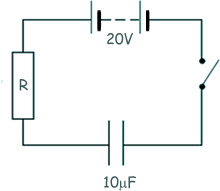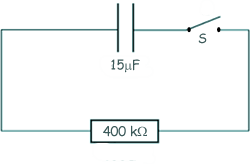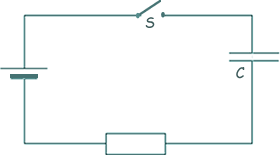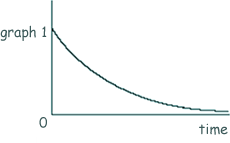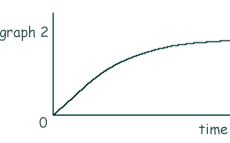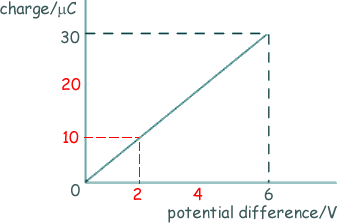Capacitors - Multiple Choice Q1. A 1μF capacitor is charged using a constant current of 10 μA for 20 s. What is the energy finally stored by the capacitor?
E = ½ QV = ½ CV2 = ½ Q2/C Q = It E = ½ (It)2/C E = ½ (10 x 10-6 x 20)2/10-6 E = 0.02 J (Choice B)
Q2. A capacitor of capacitance 10 μF is fully charged through a resistor R to a p.d. of 20V using the circuit shown below.
Which one of the following statements is incorrect?
Q3. A 10 mF capacitor is charged to 10V and then discharged completely through a small motor. During this process, the motor lifts a weight of mass 0.10 kg. If 10 % of the energy stored in the capacitor is used to lift the weight, through what approximate height will the weight be lifted?
E = ½ Q V = ½ C V2 = ½ Q2/ C 10% of E = 0.10 x ½ 10 x 10-3 x 102 = 0.05 J work done = mg=Δh 0.05 = 0.10 x 9.81 x Δh Δh = 0.05m Choice A Q4. A capacitor of capacitance 15 μF is fully charged and the potential difference across its plates is 8.0V. It is then connected into the circuit as shown below.
The switch S is closed at time t = 0. Which one of the following statements is correct?
Q5. A capacitor of capacitance C discharges through a resistor of resistance R. Which one of the following statements is not true?
Q6. In the circuit shown below, the capacitor C is charged to a potential difference V when the switch S is closed.
Which line, A to D, in the table gives a correct pair of sketch graphs showing how the charge and current change with time after S is closed?
Q7. The sketch graph shows how the charge stored by a capacitor varies with the potential difference across it as it is charged from a 6V battery.
Which one of the following statements is not correct?
Q8. A capacitor of capacitance C stores an amount of energy E when the pd across it is V. Which line, A to D, gives the correct stored energy and pd when the charge is increased by 50% ?
Q = CV so, p.d. is proportional to Q If charge is increased by a half then so will V - 1.5V E = ½ QV = ½ CV2 = ½ Q2/C E is proportional to Q2 If charge is increased by a half that is a factor of 1.5 so energy will increase by 1.52 = 2.25 Choice B
E = ½ QV = ½ CV2 = ½ Q2/C
Choice B
Q10. A voltage sensor and a datalogger are used to record the discharge of a 10 mF capacitor in series with a 500Ω resistor from an initial pd of 6.0V. The datalogger is capable of recording 1000 readings in 10s.
Which line, A to D, in the table gives the pd and the number of readings made after a time equal to the time constant of the discharge circuit? Time constant = CR = 10 x 10-3 x 500 = 5s Datalogger gives 100 readings per second Therefore in 5s it will give 500 readings. ----------------------- V = V0e-t/RC V = V0e-1 V = 6.0 x 0.368 = 2.2 volts
Choice C |
Follow me...
|



